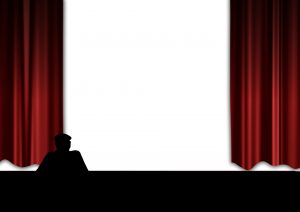18 Theater

As we take a look at theater can we find the answer to these questions?
- How does theater reflect and influence society?
How does an audience communicate with actors? - What life skills can we learn from theater?
- How does culture affect drama through history?
- How does drama bridge cultural diversity?
- How have the events in history molded drama?
Pasty Rodenburg: Why I do theater
Patsy Rodenburg says the world needs actors more than ever. In this talk at Michael Howard Studios, she tells the story of a profound encounter that reveals the deeper role theater can play in people’s lives.
Theatre or theater[a] is a collaborative form of performing art that uses live performers, typically actors or actresses, to present the experience of a real or imagined event before a live audience in a specific place, often a stage. The performers may communicate this experience to the audience through combinations of gesture, speech, song, music, and dance. Elements of art, such as painted scenery and stagecraft such as lighting are used to enhance the physicality, presence and immediacy of the experience. The specific place of the performance is also named by the word “theatre” as derived from the Ancient Greek θέατρον (théatron, “a place for viewing”), itself from θεάομαι (theáomai, “to see”, “to watch”, “to observe”).
Modern Western theatre comes, in large measure, from the theatre of ancient Greece, from which it borrows technical terminology, classification into genres, and many of its themes, stock characters, and plot elements. Theatre artist Patrice Pavis defines theatricality, theatrical language, stage writing and the specificity of theatre as synonymous expressions that differentiate theatre from the other performing arts, literature and the arts in general.
Modern theatre includes performances of plays and musical theatre. The art forms of ballet and opera are also theatre and use many conventions such as acting, costumes and staging. They were influential to the development of musical theatre; see those articles for more information. https://en.wikipedia.org/wiki/Theatre
Kabuki: The people’s dramatic art – Amanda Mattes
The Japanese dance and theater art of kabuki, derived from the word kabuku, meaning “out of the ordinary,” can be traced back to the streets of seventeenth-century Kyoto. Kabuki became a dramatic art for the common people, with its use of makeup and facial expressions rather than masks, as well as a playful take on current events. Amanda Mattes tracks the evolution of kabuki and its place in Japan’s rich cultural heritage.
Oskar Eustis: Why theater is essential to democracy (What do you think?)
Truth comes from the collision of different ideas, and theater plays an essential role in showing us that truth, says legendary artistic director Oskar Eustis. In this powerful talk, Eustis outlines his plan to reach (and listen to) people in places across the US where the theater, like many other institutions, has turned its back — like the deindustrialized Rust Belt. “Our job is to try to hold up a vision to America that shows not only who all of us are individually, but that welds us back into the commonality that we need to be,” Eustis says. “That’s what the theater is supposed to do.”
Adong Judith: How I use art to bridge misunderstanding
Director and playwright Adong Judith creates provocative art that sparks dialogue on issues from LGBTQ rights to war crimes. In this quick but powerful talk, the TED Fellow details her work — including the play “Silent Voices,” which brought victims of the Northern Ugandan war against Joseph Kony’s rebel group together with political, religious and cultural leaders for transformative talks. “Listening to one another will not magically solve all problems,” Judith says. “But it will give a chance to create avenues to start to work together to solve many of humanity’s problems.”
